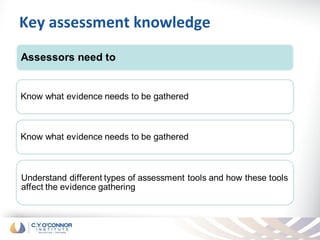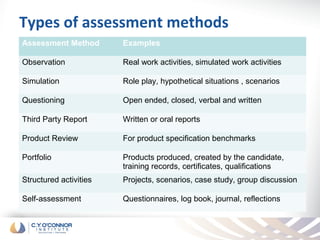Assessment methods
- 1. Assessment Cluster Topic 3 Teresa O'Brien Principal Lecturer C.Y. O’Connor Institute
- 2. Overview • Key assessment knowledge • Addressing the unit of competency • Interpreting the unit of competency/benchmark • Interpreting embedded components • Clustering competencies • Assessment methods • Record keeping and documentation
- 4. Addressing the unit of competency Ask- what does a competent performance look like? Focus on the whole unit Most specific guidance can found in the • application of the unit • performance criteria • required skills and knowledge • evidence guide • range statement
- 5. Application of the unit (how the competency applies in the workplace) The example below is taken from TAEASS401B Plan assessment activities and process Application of the Unit This unit typically applies to assessors and workplace supervisors with assessment planning responsibilities; and trainers or other assessors responsible for planning assessment, including RPL. The unit is suitable for those with an existing assessment strategy which documents the overall framework for assessment.
- 6. Elements and performance criteria Elements define the essential outcomes for achieving competency Performance criteria list what the candidate has to be able to do to demonstrate competence in each element 1. Determine assessment 1.1 Identify candidate and confirm purposes and context of assessment/RPL with relevant approach people according to legal, organisational and ethical requirements 1.2 Identify and access benchmarks for assessment/RPL and any specific assessment guidelines 2. Prepare the assessment 2.1 Determine evidence and types of evidence needed to demonstrate competence, according plan to the rules of evidence 2.2 Select assessment methods which will support the collection of defined evidence, taking into account the context in which the assessment will take place 2.3 Document all aspects of the assessment plan and confirm with relevant personnel 3. Develop assessment 3.1 Develop simple assessment instruments to meet target group needs instruments 3.2 Analyse available assessment instruments for their suitability for use and modify as required 3.3 Map assessment instruments against unit or course requirements 3.4 Write clear instructions for candidate about the use of the instruments 3.5 Trial draft assessment instruments to validate content and applicability, and record outcomes
- 7. Required skills and knowledge This section lists the specific skills and knowledge that must be collected in the assessment process and evidence documentation. The example below is only a sample! Required skills • cognitive interpretation skills to: • interpret competency standards and other assessment documentation, including material relating to reasonable adjustment • identify opportunities for integrated competency assessment • contextualise competency standards to the operating assessment environment, including RPL • consider access and equity needs of diverse candidates Required knowledge • ethical and legal requirements of an assessor • competency‑based assessment, including: • work focused • criterion referenced • standards based • evidence based • different purposes of assessment and different assessment contexts, including RPL • how to read and interpret the identified competency standards as the benchmarks for assessment
- 8. Evidence Guide This section provides advice and suggestions on
- 9. Range statement Explains key terms used in the performance criteria and defines the scope of the operating conditions and contexts that may apply in further detail. Range Statement The range statement relates to the unit of competency as a whole. It allows for different work environments and situations that may affect performance. Bold italicised wording, if used in the performance criteria, is detailed below. Essential operating conditions that may be present with training and assessment (depending on the work situation, needs of the candidate, accessibility of the item, and local industry and regional contexts) may also be included. Benchmarks for assessment/RPL may include: • criterion against which the candidate is assessed or prior learning recognised, which may be: • competency standard/unit of competency • assessment criteria of course curricula • performance specifications of an enterprise or industry • product specifications. Types of evidence may include: • direct • indirect • supplementary. Rules of evidence ensure that evidence • valid collected is: • sufficient • authentic • current.
- 10. Interpreting embedded components • Employability Skills • Language, literacy and numeracy skills (LLN) • Dimensions of Competency • AQF level of the related qualification
- 11. Employability Skills (Generic skills required in the work place) •Each qualification has a Employability Skills Summary •Facets exist for each skill •Employability skills need to be identified in the unit for teaching and assessment purposes and documented for evidence gathering purposes •Must not be assessed separately
- 12. The eight employability skills
- 13. Language Literacy and Numeracy • Can be identified at the same time as the Employability Skills • Ensure that the candidate doesn’t need LLN levels higher than that is what is needed • Some units don’t require writing skills- therefore ensure that an appropriate assessment method is being used • Where LLN is not required, ensure that the tasks allows the candidate to demonstrate competency without assessing their LLN
- 14. Dimensions of Competency Refers to all dimensions of the work performance
- 15. Clustering competencies (assessing the requirements of more than one unit of competency at a time) Reasons for clustering could include •Units of competency are interrelated •Common types of tasks (OHS, machinery, customer service) •Common skills and knowledge •Competencies exist and are used in the workplace Benefits •Efficient use of time and resources in assessment •Reflects how the competencies are enacted at work •Evidence for dimensions of competency, LLN and employability skills already available
- 16. Types of assessment methods Assessment Method Examples Observation Real work activities, simulated work activities Simulation Role play, hypothetical situations , scenarios Questioning Open ended, closed, verbal and written Third Party Report Written or oral reports Product Review For product specification benchmarks Portfolio Products produced, created by the candidate, training records, certificates, qualifications Structured activities Projects, scenarios, case study, group discussion Self-assessment Questionnaires, log book, journal, reflections
- 17. Record keeping and documentation • Assessment plans must be retained and stored • Changes to these documents needs to be recorded and version control identified • Importance of these documents need recognised • Assessment must not disrupt employees in the workplace

















